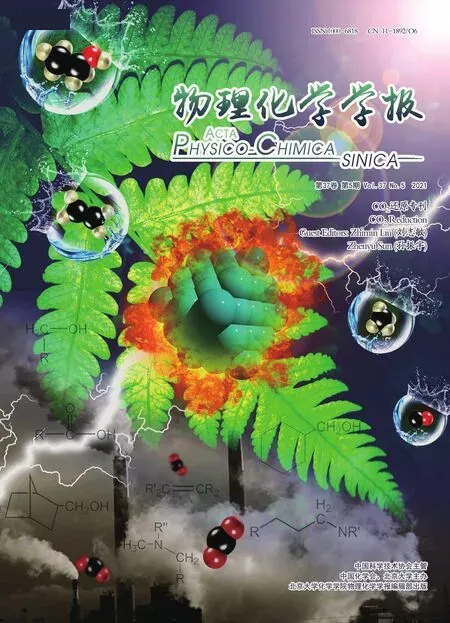Controlling the Global Mean Temperature by Decarbonization
2021-06-02FritsMathiasDautzenbergYongLuBinXu
Frits Mathias Dautzenberg , Yong Lu , Bin Xu
1 Serenix Corporation, 5632 Coppervein Street, Fort Collins, CO 80528, USA.
2 Shanghai Key Laboratory of Green Chemistry and Chemical Processes, School of Chemistry and Molecular Engineering, East China Normal University, Shanghai 200062, China.
3 ECO Zhuo Xin Energy-Saving Technology (Shanghai) Company Limited, Shanghai 201109, China.
Abstract: Establishing a reliable method to predict the global mean temperature (Te) is of great importance because CO2 reduction activities require political and global cooperation and significant financial resources.The current climate models all seem to predict that the earth’s temperature will continue to increase, mainly based on the assumption that CO2 emissions cannot be lowered significantly in the foreseeable future. Given the earth’s multifactor climate system, attributing atmospheric CO2 as the only cause for the observed temperature anomaly is most likely an oversimplification; the presence of water (H2O) in the atmosphere should at least be considered. As such, Te is determined by atmospheric water content controlled by solar activity, along with anthropogenic CO2 activities. It is possible that the anthropogenic CO2 activities can be reduced in the future. Based on temperature measurements and thermodynamic data,a new model for predicting Te has been developed. Using this model, past, current, and future CO2 and H2O data can be analyzed and the associated Te calculated. This new, esoteric approach is more accurate than various other models, but has not been reported in the open literature. According to this model, by 2050, Te may increase to 15.5 °C under “businessas-usual” emissions. By applying a reasonable green technology activity scenario, Te may be reduced to approximately 14.2 °C. To achieve CO2 reductions, the scenario described herein predicts a CO2 reduction potential of 513 gigatons in 30 years. This proposed scenario includes various CO2 reduction activities, carbon capturing technology, mineralization,and bio-char production; the most important CO2 reductions by 2050 are expected to be achieved mainly in the electricity,agriculture, and transportation sectors. Other more aggressive and plausible drawdown scenarios have been analyzed as well, yielding CO2 reduction potentials of 1051 and 1747 gigatons, respectively, in 30 years, but they may reduce global food production. It is emphasized that the causes and predictions of the global warming trend should be regarded as open scientific questions because several details concerning the physical processes associated with global warming remain uncertain. For example, the role of solar activities coupled with Milankovitch cycles are not yet fully understood. In addition,other factors, such as ocean CO2 uptake and volcanic activity, may not be negligible.
Key Words: Calculation method for global mean temperature; CO2 in the atmosphere; Water in the atmosphere;Global warming; CO2 reduction
1 Introduction
Many climate models have been developed, based on mathematical computer simulations of many factors such as the temperature of the atmosphere, the oceans and the land surface and activities on the sun and other factors. These factors all interact and are important to determine the average mean world temperature (Te) and other events related to the earth’s climate.Many scientists legitimately have wondered how accurately these climate models can predict earth’s future Te. A recent study by environmental scientists from Berkeley1has shown that the climate models published during the past five decades have skillfully described Techanges, with most examined models showing global temperature warming consistent with observations, particularly when mismatches between modelcalculated and observationally estimated were taken into account. Regarding the future Te, the current climate models all seem to predict that the earth’s temperature will continue to increase mainly assuming that CO2emissions cannot be lowered significantly in the foreseeable years.
In this paper, we will analyze observational data regarding global warming. Using readily available data, a simple calculation method for the Teis proposed since other models published in the literature are not accurately predicting the future. This new proposed model should take into consideration the water in the atmosphere and anthropogenic CO2. The simple new model must also be consistent with thermodynamic calculations of the atmospheric energy balance. We also like to show how the earth’s temperature may be decreased by certain reasonable CO2reduction activities. Other climate change events not caused by the Tehave not be the objective of this paper.
2 Data and methods
2.1 Global warming
Fig. 1 shows the Te(in blue) from 1850-2020. In brown, we indicate what the Tewould have been if the temperature increase were 0.0025 °C per year, which was the case from 1600 till 2000,according to Table 1. At this moment, the measured temperature is about 1 °C higher than the brown temperature. If this trend would continue (see Fig. 2), the Tewould be 16.4 °C by 2050,and by 2100, theTewould be 19.0 °C2. It becomes clear that the current global temperature increases of 0.0231 °C/year (from 1980 till 2019, see Table 1) is considerably higher than ever experienced on earth. However, we like to understand the causes of the observed increase of theTe, on a solid scientific basis.

Table 1 Global temperature increase per year, including data from the National Aeronautics and Space Administration (NASA) and the Goddard Institute for Space Studies (GISS).
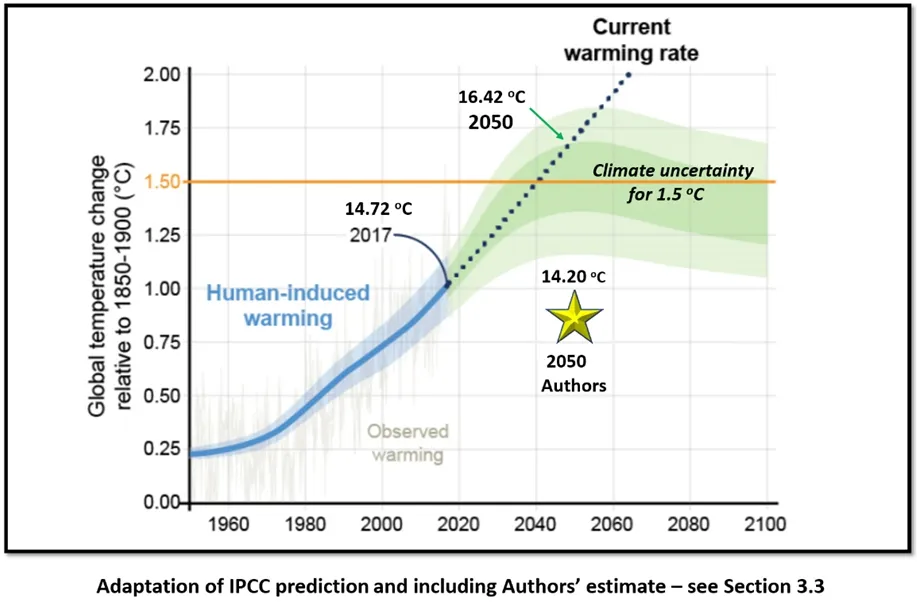
Fig. 2 Expected global temperature change according to the IPCC 2 and the author’s scenario.
2.2 Global temperature as a function of water vapor and CO2 in the atmosphere
TheTeis related to the amount of water in the atmosphere(largely controlled by solar irradiation8,9) and added CO2. The amount of CO2in the atmosphere is currently measured daily.That has not been the case for water vapor in the atmosphere.However, data from the National Aeronautics and Space Administration (NASA) covering global precipitation (in mm per day) from 1900 till 2000 allow us to estimate the water content of the atmosphere since the residence of rain is known to be approximately 9 days.
Using the observed CO2and water data of the earth’s atmosphere in 1970 and 2019 and the measuredTeat those times(see Fig. 3), one can calculate two coefficients, one for wateraand one for CO2baccording to the following equation.

Fig. 3 Calculating a and b coefficients from experimental data.

The experimental value ofa= 2.696 × 10-3in °C/(10-6(v)),while the value forb=1.065 × 10-2in °C/(10-6(v)).
Using thermodynamic data10,11, one can estimate the value ofaandb. For water, one uses the heat of formation of gaseous water, minus the heat of vaporization divided by the heat capacityCpof liquid water to calculate the coefficientain °C/(10-6(v)). Since CO2is a gas at 13.95 and 15.10 °C, one only needs the heat of formation divided by heat capacityCpfor calculatingb. The thermodynamic calculations for H2O and CO2are shown in Table 2 and Table 3. Theaandbvalues using thermodynamics are close to the experimental data, with a delta of less than 2%.

Table 2 Thermodynamic calculations * of a coefficient.

Table 3 Thermodynamic calculations * of b coefficient.
The value ofbcan be used to establish the CO2sensitivity as a function of CO2increases in the atmosphere. Starting with a CO2level is 280 (× 10-6(v)) in 1870 and 410 (× 10-6(v)) in 2019,the CO2sensitivity becomes (1.065 × 10-2) × (410 - 280) =1.38 °C. If the CO2doubled to 560 (× 10-6(v)), the CO2sensitivity would become 2.98 °C, in line with recently reported data in the literature with values from 2.2-3.4 °C12. On this basis, we estimated that the CO2in the atmosphere should not pass beyond 440 (× 10-6(v)) by 2050 if one aims at a maximum temperature increase of 1.5 °C in the future. It will be shown in Section 3.2 how this stringent objective is achievable.
3 Results
3.1 Past and future global temperatures using Eq.(1)
In many cases, one measured the Teand the CO2in 10-6(v).Fig. 4 shows data for CO2, H2O, and associated Tefrom 1880 till 2019, using Eq. (1). The observed CO2and H2O data of 1970 and 2019 were used to establish the a and b coefficients, as discussed in Section 2.2. The CO2did increase from 280 (×10-6(v)) in 1880 to 410 (× 10-6(v)) in 2019 (see Fig. 4). The concentration of H2O in the atmosphere varied slightly during this period, which is possibly a natural trend13, depending on the absorbed solar radiation. This indicates that, on average, 71% of the observed Teis caused by H2O in the atmosphere, while CO2contributes 29%.
From 1980 to 2019, the delta Teincreased from 0.50 °C to 1.44 °C, relative to maintaining CO2at 280 (× 10-6(v)), as in 1870. The delta Teincrease due to higher CO2was, therefore,0.024 °C per year from 1980 to 2019 (see Table 1), which is an alarming increase, according to the authors of the Intergovernmental Panel on Climate Change (IPCC) reports2.
As shown in references14-17, the earth’s temperatures in the past have been significantly higher than the current Te, while the levels of CO2have been higher as well as lower than the current CO2level at 410 (× 10-6(v)) (see Fig. 5). We, therefore, conclude that there is no clear correlation between the Teof the earth and the CO2in the atmosphere, as noted by other scientists as well6,18.
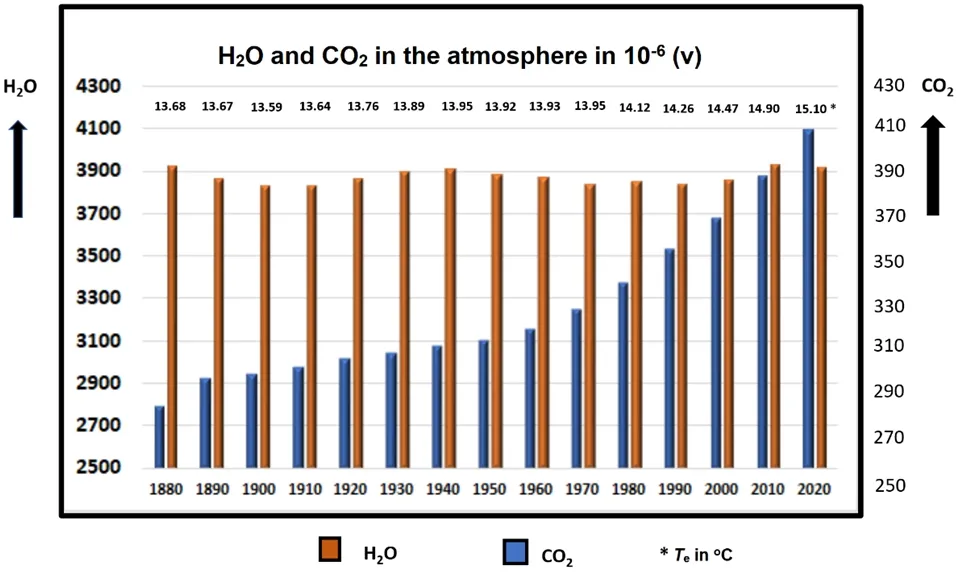
Fig. 4 CO2 and H2O in the atmosphere and associated Te from 1880 till 2019.
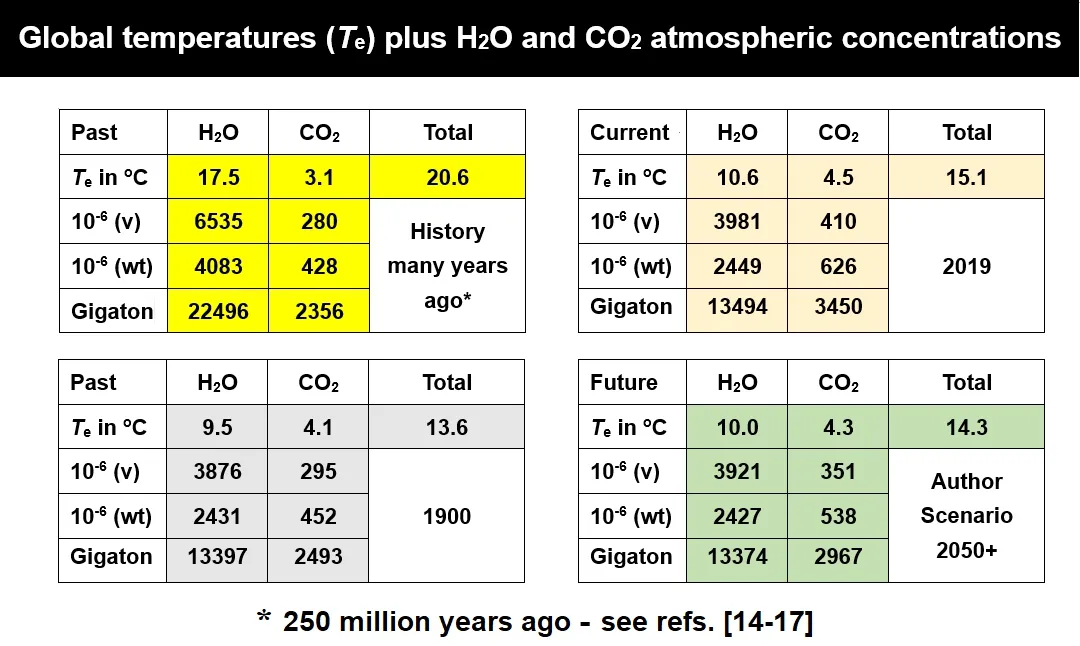
Fig. 5 CO2 and H2O in the atmosphere and associated Te in the past, current and future.

Fig. 6 Various scenarios for CO2 in the atmosphere by 2050.
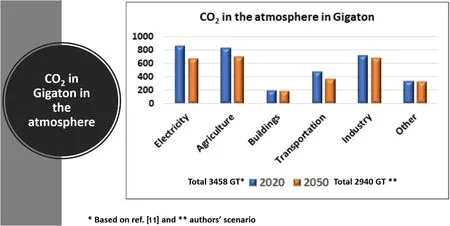
Fig. 7 CO2 in gigaton in the atmosphere, based on authors’ scenario and data from Ref. 11.
In 1998, 24.4 gigatons of CO2was added to the atmosphere,increasing to 36.6 gigatons in 201819. As a result, the atmosphere contained 3120 gigatons CO2in 1998 and 3450 gigatons in 2018. That corresponds to a CO2residence time of about 30 years, in line with various papers in the literature, e.g.,Ref. 20. Consequently, only a fraction of the emitted CO2remains in the atmosphere (equal to 0.918), while the remaining CO2will be absorbed by oceans, seas, and land, including photosynthesis activities.
3.2 Approaches to decrease CO2 in the atmosphere
Using a similar approach for calculating the CO2in the atmosphere from 1998 till 2018 (see Section 3.1) and applying a“business-as-usable” scenario, we estimate that the Tecould be 15.5 °C by 2050 and about 17.0 °C by 2100, extrapolating the Teincreased from 1980-2019 by 0.0231 °C/year (see Table 1).These Teestimates are lower than mentioned above in section 2.1 based on IPCC data, but it is more important that we agree with many scientists that everything should be done to keep the Teincrease at about 1.5-2.0 °C, including most of the participants of the IPCC2. However, it is well known that not everybody agrees with the IPCC objective (see, e.g., Refs. 5, 6,18, 21 as typical examples).
The most effective way to manage anthropologic CO2emissions is to avoid the formation of CO2. Furthermore, carbonneutral technologies may assist in greening the world. Also,photosynthesis is an essential natural method to reduce CO2from the atmosphere, and technologies that remove CO2from the atmosphere may also become viable in the future. In the following paragraphs, we will present summaries of what can be achieved.
3.2.1 Electrical power generation
It is apparent that CO2reduction options for electrical power generation are being pursued around the world. By 2050, we estimate that 215 gigatons of CO2can be avoided mainly by applying wind and solar technology.
3.2.2 Agriculture including forestry
CO2reduction in the agriculture sector is also possible22,23. In the next 30 years 471.5 gigatons of CO2emissions could be avoided. Forestry management, new agriculture technologies,and reducing food waste are likely the key areas with the most significant impact. Around the world, large scale reforestation projects are in progress, like in China, Brazil, USA, Morocco,and other countries
3.2.3 Building
Better maintenance of air conditioning equipment could potentially reduce CO2emissions by 89.4 gigatons between 2020 and 205022. Additionally, another 54.5 gigatons CO2reductions are possible using, for instance, district heating, better insulation,and LED lighting.
3.2.4 Transportation
The transportation sector can potentially reduce CO2emissions by 134 gigatons during the period from 2020 to 2050.This may be achieved using a variety of technologies. Around the world, hydrogen fueled cars, electric cars, hybrid cars and mass transportation are already actively pursued and improved ships, trucks, and airplanes will follow as well. Biomass can be converted to transportation fuels, enabling carbon neutral recycling24,25.
3.2.5 Industry
In the industry sector, fuels, and chemicals from sustainable resources24can lead to reductions in CO2emissions. Biomass,municipal solid waste, and other carbon-containing streams can be used to produce bio-SNG, bio-jet fuel, green methanol, and green ammonia25. It may take some time to transform the industry sector to greener technologies, but several companies are already working on this.
3.2.6 Other CO2reduction methods
Education and family planning are highlighted to reverse the global temperature increase25, reducing CO2emissions by 109.2 Gigatons during the next 30 years. One hopes that with education and family planning, the total world population will not increase as fast as projected.
In addition to the methods reviewed above, one can remove CO2from the atmosphere to lower the Te. The following approaches may be suitable.
3.2.7 Photosynthesis
Photosynthesis is a natural way to remove CO2from the atmosphere. This requires that the atmosphere contains at least 150 (× 10-6(v)) CO2with an optimum CO2level of 1500 (×10-6(v)). For this reason, farmers and gardeners add CO2to their greenhouses.
3.2.8 Biochar
Biochar is an emerging carbon material derived from renewable resources. This has triggered great interest in a variety of areas, including carbon sequestration and potential soil amendments26. Trees and plants do grow faster in sandy soil mixed with clay, biochar, and mycorrhizae fungi if one has enough water. This had been demonstrated successfully, for instance, in the Gobi Desert in China and around the Sahara for the Great Green Wall initiative.
3.2.9 CO2mineralization
To date, the most widely accepted method of carbon capture and storage (CCS) is the injection of CO2into underground geological formations and reservoirs. However, the risk remains that potentially suitable reservoirs may turn out to be insufficient, uneconomic, or impractical27.
Carbon capture and mineral carbonation (CCMC), also called CO2mineralization, has been identified by the IPCC as a possible promising additional technology to remove CO2from the atmosphere. CCMC is a process whereby CO2is chemically reacted with calcium- and/or magnesium-containing minerals to form stable carbonate materials which do not incur any longterm liability or monitoring commitments. CCMC is highly verifiable and permanent in nature. Companies are pursuing CCMC, and demonstration pilot plants have already been in operation28. Australia recently discovered large deposits of halloysite-kaolin clay that can be used for CCMC29.
3.2.10 Direct air capture of CO2
Biochar plus CO2mineralization can potentially remove about 78 gigatons of CO2in 30 years, as estimated in Ref. 22. By 2050,direct air capture of CO2could become an additional viable technology, if the captured CO2is used for CCS and/or CCMC.
3.2.11 Geoengineering
Star Technology and Research30has designed a system of space mirrors that blocks sunlight from reaching the earth and provides another source of clean energy for the earth. These spacecraft mirrors are remotely controlled and equipped with solar panels that collect some of the sunlight and send the captured energy back down to earth. However, geoengineering has many potential pitfalls that have not made it popular with scientists, whose climate platforms focus instead on ways to reduce the earth away from fossil fuels31.
3.3 Applying scenarios to reduce CO2 emissions
Five scenarios have been developed (see Fig. 6), using similar calculations to assess the CO2in the atmosphere from 1998 to 2018, shown in Section 3.2. The first scenario, called “Businessas-usable” (BAU), extrapolates the current CO2emissions data13until 2050, leading to an increase of 531 gigatons CO2in the atmosphere. The Shell scenario32is a little better than the BAU scenario but still increases the CO2in the atmosphere of 351 gigatons. The most aggressive scenarios are called “Plausible”and “Drawdown” based on Ref. 22. The input of 192 well-known environmental experts, scientists, engineers, architects, lawyers and writers have contributed to the formulation of the Plausible and Drawdown scenarios. The Plausible scenario is an optimistic, feasible frame work and forecast of CO2reduction activities that could impact the global climate with a total CO2reduction of 1051 gigatons in 30 years. The Drawdown scenario describes the most comprehensive plan to reverse global warming. It shows what would happen when the more conservative assumptions of the Plausible scenario are removed.In this case, a total CO2reduction of 1747 gigatons in 30 years could be realized. The proposed authors’ scenario is selected as an achievable compromise approach, predicting a CO2reduction potential of 513 gigatons. Fig. 6 also lists corresponding global Tein °C and the expected CO2in 10-6(v). The Plausible and the Drawdown scenarios would affect global food production since the CO2would drop to 240 (× 10-6(v)) and 205 (× 10-6(v)), lower than in 1850.
The anthropologic CO2emission in 2020 is estimated to lead to 3458 gigatons of CO2in the atmosphere, applying the trends shown on Ref. 19. According to the author’s scenario, the CO2in the atmosphere would reduce to 2945 gigatons. The distribution of this amount by sectors of activity is shown in Fig.7. The data indicates that relative to 2020, the most important CO2reductions by 2050 are expected to be achieved mainly in the electricity, agriculture, and transportation sectors.
4 Conclusion and discussion
It is a fact that the mean temperature of the earth has been increasing slightly during the past 60 years, which is supported by numerous data. Referring to Section 3.1, the a and b coefficients are based on observational data such as the Te, the CO2in the atmosphere, and water in the atmosphere derived from rainfall records. The thermodynamic calculated a and b coefficients are in line with the experimental values.Furthermore, the 0.918 CO2decrease rate per year used in Section 3.1 shows that CO2remains in the atmosphere for many years, while water in the atmosphere only stays about 9 days.The amount of water in the atmosphere is, however, more dominant in terms of the earth’s temperature than the contribution of CO2. The amount of water hardly changed from 1850 till 2020, independent of the increasing CO2amount. Fig.2 illustrates the expected Teaccording to the IPCC2and the author’s scenario. If “Business as usable” is happening, the IPCC projects that the Tecould increase to 16.4 °C by 2050. Applying the correlations describes in Section 3.2, we estimate that the Temay increase to 15.5 °C for a “Business as usable” scenario.According to the author’s scenario, a Teof 14.2 °C seems to be achievable by 2050. Using the proposed simple model to calculate Temay seem to be an oversimplification, since it does not predict other important climate events, which were not part of the paper’s objective.
Indeed, several questions regarding physical processes associated with global warming remain unanswered. That means that the causes and prediction of the global warming trend should be considered as open scientific questions. For instance, the roles of sun activities coupled with Milankovitch cycles, are not fully understood yet. Also, other factors like ocean CO2uptake and volcanic activities, may not be negligible.
Basing the multi-factor earth’s climate system to CO2in the atmosphere as the only variable causing the observed temperature anomaly is most likely an oversimplification,because one should at least consider the presence of water in the atmosphere. That does not mean that efforts to lower CO2emissions should not be pursued because getting to a fossil-free world is ultimately unavoidable and will create progress in many ways.
Conflict of interest: The authors declare that they have no conflict of interest.
杂志排行
物理化学学报的其它文章
- Understanding the Role of Cu/ZnO lnteraction in CO2 Hydrogenation to Methanol
- Electrocatalytic CO2 Reduction to Ethylene over CeO2-Supported Cu Nanoparticles: Effect of Exposed Facets of CeO2
- Cu@UiO-66 Derived Cu+-ZrO2 Interfacial Sites for Efficient CO2 Hydrogenation to Methanol
- 二氧化碳电还原反应的理论研究
- 离子液体介导CO2化学转化研究进展
- 过渡金属催化CO2/H2参与的羰基化研究进展
